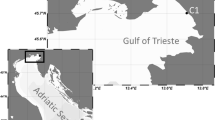Abstract
The bacterial diversity and abundance in snow of the summit (8201 m) of Cho Oyu mountain, Tibet, were analyzed by 16S rRNA gene sequencing followed by scanning electronic microscopy analysis. Most of bacteria were found to be of spherical or oval shape (>95%). Bacterial 16S rDNA sequences were classified into 5 genera (Caulobacter, Ralstonia, Cupriavidus, Pelomonas and Pseudomonas). Gammaproteobacteria were the most abundant (91.25%) among the library that consists of 594 clones. The sequences found in this study are highly similar to those previously retrieved from other cold environments, such as ice core, sea ice, permafrost and snow. The results showed that the cold and barren environments strongly influence the survival of bacteria. The high similarity among sequences retrieved from snow sample and other places, such as ocean, soil and water, suggested that the bacteria in snow, soil and water environments have the same origin.
Similar content being viewed by others
References
Gentile G, Giuliano L, D’Auria G, et al. Study of bacterial communities in Antarctic coastal waters by a combination of 16S rRNA and 16S rDNA sequencing. Environ Microbiol, 2006, 8(12): 2150–2161
Tindall B J. Prokaryotic diversity in the Antarctic: The tip of the iceberg. Microb Ecol, 2004, 47(3): 271–283
Miteva V I, Brenchley J E. Detection and isolation of ultrasmall microorganisms from a 120,000-year-old Greenland glacier ice core. Appl Environ Microbiol, 2005, 71(12): 7806–7818
Zhang X J, Yao T D. Progress and significance of studies on microorganisms in deep glacial ice (in Chinese). Chin J Polar Res, 2000, 12(4): 269–274
Ewing B, Hillier L, Wendl M C, et al. Base-calling of automated sequencer traces using phred. I. Accuracy assessment. Genome Res, 1998, 8(3): 175–185
Ewing B, Green P. Base-calling of automated sequencer traces using phred. II. Error probabilities. Genome Res, 1998, 8(3): 186–194
Green P. PHRAP. 0.990319, http://www.phrap.org
Gordon D, Abajian C, Green P. Consed: A graphical tool for sequence finishing. Genome Res, 1998, 8(3): 195–202
Ashelford K E, Chuzhanova N A, Fry J C, et al. New screening software shows that most recent large 16S rRNA gene clone libraries contain chimeras. Appl Environ Microbiol, 2006, 72(9): 5734–5741
Ashelford K E, Chuzhanova N A, Fry J C, et al. At Least 1 in 20 16S rRNA sequence records currently held in public repositories is estimated to contain substantial anomalies. Appl Environ Microbiol, 2005, 71(12): 7724–7736
Altschul S F, Gish W, Miller W, et al. Basic local alignment search tool. J Mol Biol, 1990, 215(3): 403–410
Cole J R, Chai B, Farris R J, et al. The Ribosomal Database Project (RDP-II): Sequences and tools for high-throughput rRNA analysis. Nucleic Acids Res, 2005, 33(Database issue): D294–D296
Thompson J D, Gibson T J, Plewniak F, et al. The CLUSTAL_X windows interface: Flexible strategies for multiple sequence alignment aided by quality analysis tools. Nucleic Acids Res, 1997, 25(24): 4876–4882
Kumar S, Tamura K, Nei M. MEGA3: Integrated software for molecular evolutionary genetics analysis and sequence alignment. Brief Bioinform, 2004, 5(2): 150–163
Wang G C, Wang Y. Frequency of formation of chimeric molecules as a consequence of PCR coamplification of 16S rRNA genes from mixed bacterial genomes. Appl Environ Microbiol, 1997, 63(12): 4645–4650
Wang G, Wang Y. The frequency of chimeric molecules as a consequence of PCR co-amplification of 16S rRNA genes from different bacterial species. Microbiology, 1996, 142(5): 1107–1114
Xiang S R, Yao T D, An L Z, et al. Community change of bacteria and differences in bacteria isolated from the Muztag Ata glacier at increasing depths. Sci China Ser D-Earth Sci, 2005, 35(3): 252–262
Segawa T, Miyamoto K, Ushida K, et al. Seasonal change in bacterial flora and biomass in mountain snow from the Tateyama Mountains, Japan, analyzed by 16S rRNA gene sequencing and real-time PCR. Appl Environ Microbiol, 2005, 71(1): 123–130
Mitskevich I N, Poglazova M N, Abyzov S S, et al. Microorganisms found in the basal horizons of the Antarctic glacier above Lake Vostok. Dokl Biol Sci, 2001, 381: 582–585
Priscu J C, Fritsen C H, Adams E E, et al. Perennial Antarctic lake ice: An oasis for life in a polar desert. Science, 1998, 280(5372): 2095–2098
Haselwandter K, Ebner M R. Microorganisms surviving for 5300 years. FEMS Microbiol Lett, 1994, 116(2): 189–193
Haselwandter K, Ebner M R. Further evidence in support of the authenticity of microorganisms believed to have survived for 5300 years. FEMS Microbiol Lett, 1994, 120(1-2): 11–12
Author information
Authors and Affiliations
Corresponding author
Additional information
Contributed equally to this work
Supported by the Knowledge Innovation Project of Chinese Academy of Sciences (Grant No. KSCX2-SW-331).
About this article
Cite this article
Tong, X., Chen, F., Yu, J. et al. Phylogenetic identification and microbial diversity in snow of the summit (8201 m) of Cho Oyu Mountain, Tibet. Chin. Sci. Bull. 53, 3317–3323 (2008). https://doi.org/10.1007/s11434-008-0424-0
Received:
Accepted:
Published:
Issue Date:
DOI: https://doi.org/10.1007/s11434-008-0424-0




